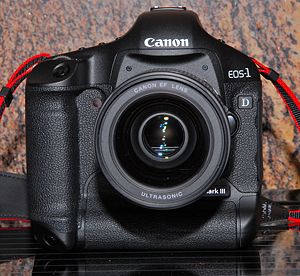 | |
| Overview | |
|---|---|
| Type | Digital single-lens reflex |
| Released | May 2007 |
| Lens | |
| Lens | Interchangeable (EF) |
| Sensor/medium | |
| Sensor | 28.1mm × 18.7mm (1.3x conversion factor) CMOS, APS-H Format (10.1 effective megapixels) |
| Maximum resolution | 3,888 × 2,592 (10 million) |
| Storage media | CompactFlash (Type I or Type II), Secure Digital, External Hard Drive or other USB Storage Devices. |
| Focusing | |
| Focus modes | Autofocus (One-Shot AF, Predictive AI Servo AF), Manual Focus (MF) |
| Focus areas | 45 AF points (19 cross-type and 26 Assist AF points) |
| Exposure/metering | |
| Exposure metering | 63-zone TTL full aperture metering |
| Metering modes | Evaluative metering (linked to all AF points), Partial metering (approx. 13.5% of screen, at center), Spot metering (approx. 3.8% of screen), Centerweighted average metering |
| Shutter | |
| Shutter | Vertical-travel, mechanical, focal-plane shutter with all speeds electronically controlled |
| Shutter speed range | 1/8000 to 30 sec. (1/3-stop increments) |
| Continuous shooting | 10frame/s up to 22/30/110 frames (raw+JPEG Large Fine/raw/JPEG Large Fine) |
| Viewfinder | |
| Viewfinder | Optical |
| General | |
| LCD screen | 3.0 in, 230,000 pixels (690,000 dots) TFT color, liquid-crystal monitor |
| Made in | Japan |
| Chronology | |
| Replaced | Canon EOS-1D Mark II N[1] |
| Successor | Canon EOS-1D Mark IV[2] |
The EOS 1D Mark III is a professional 10.1 megapixel digital single lens reflex camera (DSLR) camera body produced by Canon. The EOS 1D Mark III was announced on February 21, 2007[3] and is the successor of the Canon EOS-1D Mark II N and was first released in May 2007. In late 2009, the camera was succeeded by the Canon EOS-1D Mark IV. One of the main benefits of the new Mark III, over the previous models, was the added functionality of Live view, allowing users to take pictures while looking at an LCD screen. While it had the same outdated software as the older 1D series cameras, it had a much improved button layout, which is still used today. It also had improved wireless capabilities (with the optional WFT-E2 wireless adapter) over the Mark II. The new WFT-E2 was much smaller than the previous WFT-E1 for the Mark II. The new transmitter could now also connect via a USB port. This allowed the optional addition of a GPS unit and wired PC connectivity.
- ^ "EOS-1D Mark III - Canon Camera Museum".
- ^ "What's New in the EOS-1D Mark IV: Improved CMOS Sensor".
- ^ "CANON RELEASES THE EOS-1D MARK III DIGITAL SLR". 2007-02-21. Retrieved 2009-10-25.